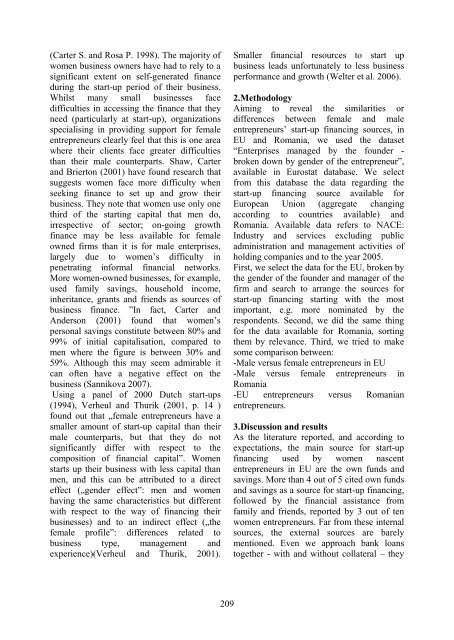Selected papers~ SPECIAL EDITION - Index of
Selected papers~ SPECIAL EDITION - Index of
Selected papers~ SPECIAL EDITION - Index of
You also want an ePaper? Increase the reach of your titles
YUMPU automatically turns print PDFs into web optimized ePapers that Google loves.
(Carter S. and Rosa P. 1998). The majority <strong>of</strong><br />
women business owners have had to rely to a<br />
significant extent on self-generated finance<br />
during the start-up period <strong>of</strong> their business.<br />
Whilst many small businesses face<br />
difficulties in accessing the finance that they<br />
need (particularly at start-up), organizations<br />
specialising in providing support for female<br />
entrepreneurs clearly feel that this is one area<br />
where their clients face greater difficulties<br />
than their male counterparts. Shaw, Carter<br />
and Brierton (2001) have found research that<br />
suggests women face more difficulty when<br />
seeking finance to set up and grow their<br />
business. They note that women use only one<br />
third <strong>of</strong> the starting capital that men do,<br />
irrespective <strong>of</strong> sector; on-going growth<br />
finance may be less available for female<br />
owned firms than it is for male enterprises,<br />
largely due to women’s difficulty in<br />
penetrating informal financial networks.<br />
More women-owned businesses, for example,<br />
used family savings, household income,<br />
inheritance, grants and friends as sources <strong>of</strong><br />
business finance. ”In fact, Carter and<br />
Anderson (2001) found that women’s<br />
personal savings constitute between 80% and<br />
99% <strong>of</strong> initial capitalisation, compared to<br />
men where the figure is between 30% and<br />
59%. Although this may seem admirable it<br />
can <strong>of</strong>ten have a negative effect on the<br />
business (Sannikova 2007).<br />
Using a panel <strong>of</strong> 2000 Dutch start-ups<br />
(1994), Verheul and Thurik (2001, p. 14 )<br />
found out that „female entrepreneurs have a<br />
smaller amount <strong>of</strong> start-up capital than their<br />
male counterparts, but that they do not<br />
significantly differ with respect to the<br />
composition <strong>of</strong> financial capital”. Women<br />
starts up their business with less capital than<br />
men, and this can be attributed to a direct<br />
effect („gender effect”: men and women<br />
having the same characteristics but different<br />
with respect to the way <strong>of</strong> financing their<br />
businesses) and to an indirect effect („the<br />
female pr<strong>of</strong>ile”: differences related to<br />
business type, management and<br />
experience)(Verheul and Thurik, 2001).<br />
209<br />
Smaller financial resources to start up<br />
business leads unfortunately to less business<br />
performance and growth (Welter et al. 2006).<br />
2.Methodology<br />
Aiming to reveal the similarities or<br />
differences between female and male<br />
entrepreneurs’ start-up financing sources, in<br />
EU and Romania, we used the dataset<br />
“Enterprises managed by the founder -<br />
broken down by gender <strong>of</strong> the entrepreneur”,<br />
available in Eurostat database. We select<br />
from this database the data regarding the<br />
start-up financing source available for<br />
European Union (aggregate changing<br />
according to countries available) and<br />
Romania. Available data refers to NACE:<br />
Industry and services excluding public<br />
administration and management activities <strong>of</strong><br />
holding companies and to the year 2005.<br />
First, we select the data for the EU, broken by<br />
the gender <strong>of</strong> the founder and manager <strong>of</strong> the<br />
firm and search to arrange the sources for<br />
start-up financing starting with the most<br />
important, e.g. more nominated by the<br />
respondents. Second, we did the same thing<br />
for the data available for Romania, sorting<br />
them by relevance. Third, we tried to make<br />
some comparison between:<br />
-Male versus female entrepreneurs in EU<br />
-Male versus female entrepreneurs in<br />
Romania<br />
-EU entrepreneurs versus Romanian<br />
entrepreneurs.<br />
3.Discussion and results<br />
As the literature reported, and according to<br />
expectations, the main source for start-up<br />
financing used by women nascent<br />
entrepreneurs in EU are the own funds and<br />
savings. More than 4 out <strong>of</strong> 5 cited own funds<br />
and savings as a source for start-up financing,<br />
followed by the financial assistance from<br />
family and friends, reported by 3 out <strong>of</strong> ten<br />
women entrepreneurs. Far from these internal<br />
sources, the external sources are barely<br />
mentioned. Even we approach bank loans<br />
together - with and without collateral – they


